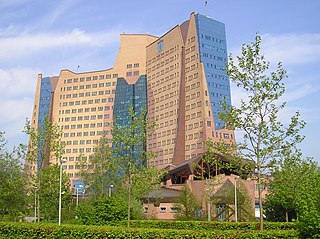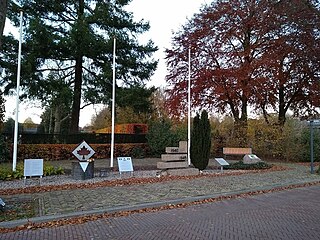
This is a chronological overview of the dates at which the liberation by the Allies in World War II took place of a number of Dutch cities and towns.

This is a chronological overview of the dates at which the liberation by the Allies in World War II took place of a number of Dutch cities and towns.
The battle of Overloon started on 30 September

Groningen is the capital city and main municipality of Groningen province in the Netherlands. The capital of the north, Groningen is the largest place as well as the economic and cultural centre of the northern part of the country; as of December 2021, it had 235,287 inhabitants, making it the sixth largest city/municipality in the Netherlands and the second largest outside the Randstad.

Utrecht is the fourth-largest city of the Netherlands, as well as the capital and the most populous city of the province of Utrecht. The municipality of Utrecht is located in the eastern part of the Randstad conurbation, in the very centre of mainland Netherlands, and includes Haarzuilens, Vleuten en De Meern. It has a population of 361,699 as of December 2021.

Arnhem is a city and municipality situated in the eastern part of the Netherlands. It is the capital of the province of Gelderland, located on both banks of the rivers Nederrijn and Sint-Jansbeek, which was the source of the city's development. Arnhem had a population of 163,972 on 1 December 2021, which made it one of the larger cities of the Netherlands.

Gelderland, also known as Guelders in English, is a province of the Netherlands, occupying the centre-east of the country. With a total area of 5,136 km2 (1,983 sq mi) of which 173 km2 (67 sq mi) is water, it is the largest province of the Netherlands by land area, and second by total area. Gelderland shares borders with six other provinces and the German state of North Rhine-Westphalia.

Wageningen is a municipality and a historic city in the central Netherlands, in the province of Gelderland. It is famous for Wageningen University, which specialises in life sciences. The municipality had a population of 39,635 in 2021, of which many thousands are students from over 150 countries.

Despite Dutch neutrality, Nazi Germany invaded the Netherlands on 10 May 1940 as part of Fall Gelb. On 15 May 1940, one day after the bombing of Rotterdam, the Dutch forces surrendered. The Dutch government and the royal family relocated to London. Princess Juliana and her children sought refuge in Ottawa, Canada until after the war.

Operation Anger was a military operation to seize the city of Arnhem in April 1945, during the closing stages of the Second World War. It is also known as the Second Battle of Arnhem or the Liberation of Arnhem. The operation was part of the Canadian First Army's liberation of the Netherlands and was led by the 49th British Infantry Division, supported by armour of the 5th Canadian Armoured Division, Royal Air Force air strikes and boats of the Royal Navy.

Arnhem Centraal railway station is the largest railway station in the city of Arnhem in Gelderland, Netherlands. It was opened on 14 May 1845 and is located on the Amsterdam–Arnhem railway, the Arnhem–Leeuwarden railway and the Arnhem–Nijmegen railway. The station opened at the same time as the Amsterdam–Arnhem railway, that continues into Germany via the Oberhausen–Arnhem railway.
The 2009–10 Eredivisie was the 54th season of Eredivisie since its establishment in 1955. AZ were the reigning champions. A total of 18 teams is taking part in the league, consisting of 16 who competed in the previous season and two promoted from the Eerste Divisie. The teams promoted from the Eerste Divisie at the end of the previous season were champions VVV-Venlo and promotion/relegation play-off winners RKC Waalwijk.
The 2013–14 season was Feyenoord's 106th season of play, it marked its 58th season in the Eredivisie and its 92nd consecutive season in the top flight of Dutch football. They ended their league campaign as runners-up. They entered the KNVB Cup in the second round and reached the quarter-final. Their Europa League appearance consisted of the play-off round. It was the third straight season with manager Ronald Koeman, who did not renew his contract at the conclusion of the season.
The 2014–15 season was Feyenoord's 107th season of play, it marked its 59th season in the Eredivisie and its 93rd consecutive season in the top flight of Dutch football. It was first season with manager Fred Rutten. The club was busy during the summer transfer window, selling or releasing of 12 players and signing 13 new players. Feyenoord had a bad start of the season, dropping to 15th place in the league after losing three and drawing two of its first six league games. They played only the second round of the KNVB Cup; they were knocked out by Go Ahead Eagles. The club also lasted a single round in the Champions League; the third qualifying round consisted of two losses to Beşiktaş. They reached the Europa League group stage by beating FC Zorya Luhansk 4–3 at home after an away draw. The team improved after this early showing. A five-game winning streak catapulted them to third place in the Eredivisie by mid fall. They also reached the knockout phase of the Europa League by beating Standard Liège, HNK Rijeka and title holders Sevilla in the group phase. They went into the winter break placed third in the league.
The 2014–15 KNVB Cup was the 97th season of the Dutch national football knockout tournament. The competition began on 27 August 2014 with the matches of Round 1 and ended with the final on 3 May 2015. The winner qualified for the group stage of the 2015–16 UEFA Europa League.

Liberation Route Europe is an international remembrance trail that connects the main regions along the advance of the Western Allied Forces toward the liberation of Europe and final stage of the Second World War. The route started in 2008 as a Dutch regional initiative in the Arnhem-Nijmegen area and then developed into a transnational route that was officially inaugurated in Arromanches on June 6, 2014, during the Normandy D-day commemorations. The route goes from Southern England through France, Belgium, Luxembourg, the Netherlands to Berlin in Germany, then extends to the Czech Republic and Poland. The southern route starts in Italy. As a form of remembrance tourism, LRE aims to unfold these Allied offensives of 1944 and 1945 in one narrative combining the different perspectives and points of view. By combining locations with personal stories of people who fought and suffered there, it gives visitors the opportunity to follow the Allied march and visit significant sites from war cemeteries to museums and monuments but also events and commemorations. In April 2019, Liberation Route Europe became a certified Cultural Route of the Council of Europe.

The Battle of Nijmegen, also known as the Liberation of Nijmegen, occurred from 17 to 20 September 1944, as part of Operation Market Garden during World War II.

HNLMS Wassenaar, was a unique ship built for the Royal Netherlands Navy.
Events in the year 1944 in the Netherlands.
Events in the year 1945 in the Netherlands.

The Battle of Otterlo was fought in the Netherlands on 16-17 April 1945. German soldiers were encircled on the De Hoge Veluwe National Park and unexpectedly attacked the already liberated Dutch village Otterlo, leading to fierce fighting in hand-to-hand combat. It resulted in an Allied victory, thanks to the deployment of flamethrower tanks, and considerable German losses.
This timeline is about events during World War II of direct significance to the Netherlands. For a larger perspective, see Timeline of World War II.